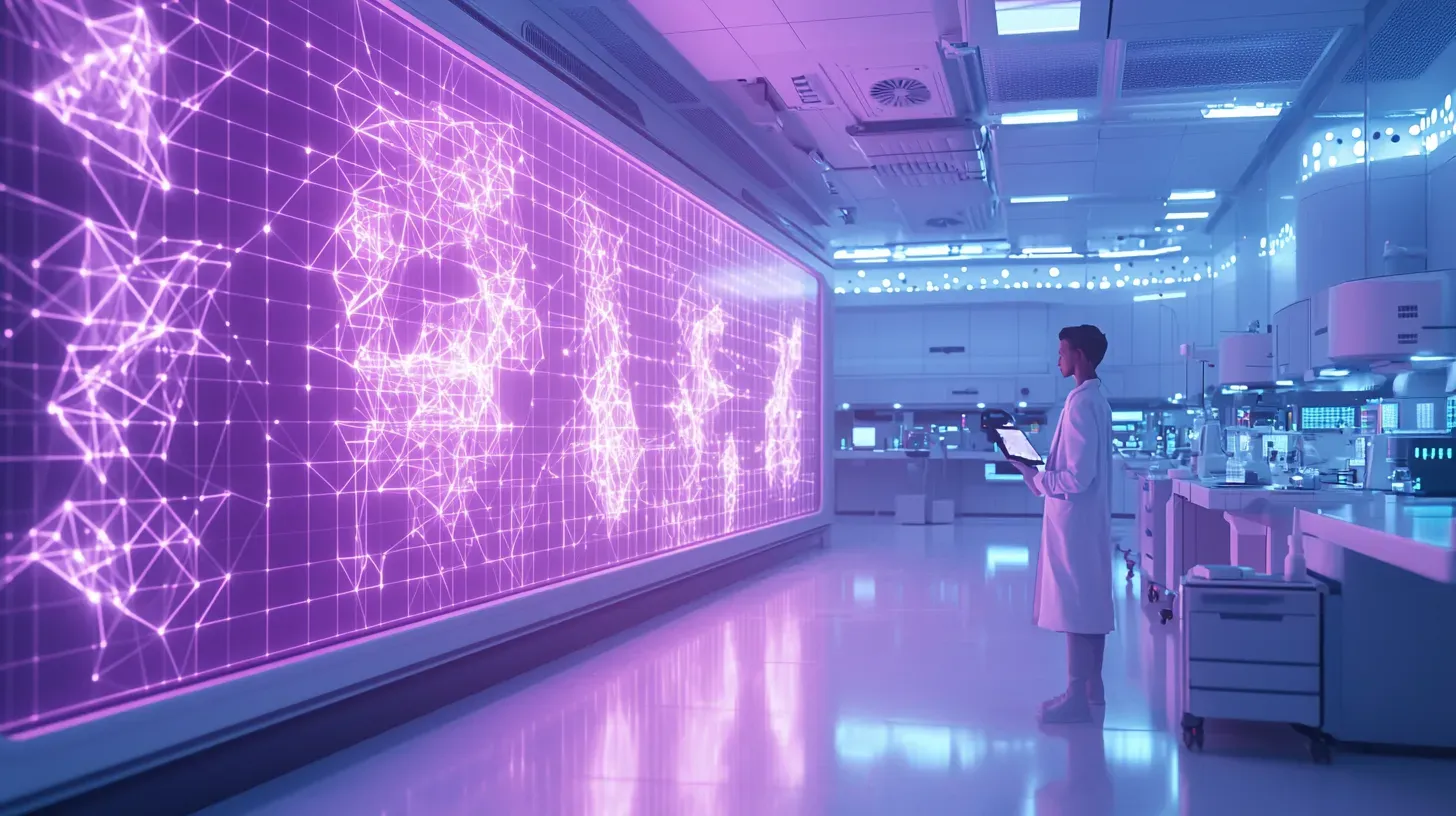An Innovation Futurist's Insight into Understanding Digital Twins

An Innovation Futurist's Insight into Understanding Digital Twins
In the ever-evolving landscape of technology, digital twins have emerged as a fascinating concept that promises to revolutionize numerous industries. As an innovation futurist, it is my pleasure to provide you with a comprehensive understanding of digital twins and their significance in our rapidly digitizing world.
Understanding the Concept of Digital Twins
Before delving into the intricacies of digital twins, it is essential to grasp the fundamental concept behind this technology. Simply put, a digital twin is a virtual replica or representation of a physical object, process, or system. It acts as a bridge between the physical and digital realms, allowing real-time monitoring, analysis, and control.
The digital twin is not merely a static image or model. It is a dynamic entity that constantly receives and generates data, providing valuable insights into the physical counterpart's performance, behavior, and condition. By leveraging cutting-edge technologies such as artificial intelligence, machine learning, and the Internet of Things, digital twins enable enhanced decision-making, predictive analytics, and improved operational efficiency.
Imagine a scenario where a manufacturing company utilizes digital twin technology to monitor and optimize its production line. The digital twin, in this case, would be a virtual representation of the entire manufacturing process, from raw materials to finished products. It would capture real-time data from sensors placed throughout the production line, monitoring variables such as temperature, pressure, and machine performance.
With this wealth of data, the digital twin can provide valuable insights into the production line's efficiency, identifying bottlenecks, predicting maintenance needs, and optimizing the overall workflow. For example, if the digital twin detects a decrease in machine performance, it can alert the operators and suggest adjustments to prevent downtime or quality issues.
Furthermore, digital twins can also facilitate remote monitoring and control. Imagine a power plant that utilizes digital twin technology to monitor its operations. With a digital twin in place, operators can remotely access real-time data and analytics, allowing them to make informed decisions and take proactive measures to prevent potential failures or optimize energy generation.
Another fascinating application of digital twins is in the field of healthcare. Imagine a patient with a chronic condition that requires continuous monitoring. With a digital twin, healthcare professionals can create a virtual representation of the patient's physiological parameters, such as heart rate, blood pressure, and glucose levels. This digital twin can continuously receive data from wearable devices and sensors, allowing healthcare providers to closely monitor the patient's condition and intervene if necessary.
Moreover, digital twins can also be utilized in urban planning and infrastructure management. By creating digital twins of cities or specific infrastructure systems like transportation networks or water supply systems, urban planners can simulate various scenarios and evaluate the impact of different interventions. This can help optimize traffic flow, improve energy efficiency, and enhance overall urban resilience.
In conclusion, digital twins are not just static representations of physical objects or systems. They are dynamic entities that enable real-time monitoring, analysis, and control. By leveraging advanced technologies, digital twins provide valuable insights, facilitate predictive analytics, and enhance decision-making across various industries and sectors. As the world becomes increasingly interconnected, the potential of digital twins to revolutionize how we understand and interact with the physical world is truly remarkable.
The Role of an Innovation Futurist in Digital Twin Technology
As an innovation futurist, my role is to anticipate and embrace emerging technologies that have the potential to shape the future. I am dedicated to exploring novel applications and uncovering the untapped possibilities of digital twin technology. By staying at the forefront of innovation, I can provide valuable insights and guidance to organizations seeking to harness the power of digital twins.
I collaborate with diverse stakeholders, including engineers, data scientists, and business leaders, to architect innovative solutions. By fostering an environment of curiosity and collaboration, I ensure that digital twins are integrated seamlessly into existing workflows and processes. With my expertise, organizations can unlock the full potential of this transformative technology and gain a competitive edge in their respective industries.
One of the key aspects of my role as an innovation futurist is to constantly stay updated with the latest advancements in digital twin technology. This involves conducting extensive research, attending conferences and workshops, and engaging in discussions with industry experts. By immersing myself in the world of digital twins, I am able to identify emerging trends and foresee potential challenges that organizations may face when implementing this technology.
When collaborating with engineers, I work closely with them to understand their specific needs and challenges. By doing so, I can provide tailored solutions that address their unique requirements. For example, if an engineering team is working on a complex infrastructure project, I can help them create a digital twin that accurately simulates the behavior of the structure under different conditions. This enables them to identify potential issues and make informed decisions before any physical construction takes place.
In addition to working with engineers, I also collaborate with data scientists to leverage the power of data in digital twin technology. By analyzing large datasets collected from sensors and other sources, we can gain valuable insights into the performance and behavior of physical assets. This data-driven approach allows organizations to optimize their operations, improve maintenance strategies, and reduce costs.
Furthermore, my role as an innovation futurist involves working closely with business leaders to identify opportunities for digital twin implementation. I help them understand the potential benefits and ROI of adopting this technology, and assist in developing a strategic roadmap for its implementation. By aligning digital twin initiatives with the organization's overall goals and objectives, we can ensure a seamless integration and maximize the value derived from this technology.
As the field of digital twin technology continues to evolve, my role as an innovation futurist becomes increasingly important. By staying ahead of the curve and anticipating future trends, I can guide organizations towards innovative solutions that drive growth and success. Whether it's in the manufacturing, healthcare, or transportation sector, digital twins have the potential to revolutionize industries and redefine the way we interact with the physical world. As an innovation futurist, I am committed to unlocking this potential and helping organizations thrive in the digital age.
Decoding the Benefits of Digital Twins
The benefits of digital twins are manifold, delivering tangible advantages across various sectors. For instance, in manufacturing, digital twins help optimize production processes, enabling predictive maintenance, reducing downtime, and streamlining operations. By analyzing real-time data from the digital twin, manufacturers can identify inefficiencies, enhance productivity, and prevent costly breakdowns.
In manufacturing, digital twins have revolutionized the way products are designed and manufactured. With the help of virtual simulations, engineers can test different design iterations and evaluate their performance in a virtual environment. This not only saves time and resources but also ensures that the final product meets the desired specifications. Additionally, digital twins enable manufacturers to monitor the health and performance of their equipment in real-time, allowing them to schedule maintenance activities proactively and avoid unexpected failures.
In healthcare, digital twins facilitate personalized medicine by simulating an individual's unique physiological traits. This enables accurate diagnosis, personalized treatment plans, and improved patient outcomes. By creating a digital replica of a patient, healthcare professionals can analyze various scenarios and predict the effectiveness of different treatment options. This not only improves the quality of care but also reduces the risk of adverse reactions and unnecessary procedures.
Moreover, digital twins are transforming the way cities are planned and managed. In the smart cities domain, digital twins can optimize urban infrastructure, enhance energy efficiency, and enable proactive city planning. By creating a virtual replica of a city, urban planners can simulate different scenarios and evaluate the impact of various interventions. This allows them to make informed decisions about infrastructure development, traffic management, and resource allocation, leading to more sustainable and livable cities.
However, the benefits of digital twins extend beyond specific industries. They also empower organizations to make data-driven decisions, improve customer experiences, and foster innovation. By harnessing the power of digital twins, companies can create more agile and resilient operations, driven by real-time insights and advanced analytics.
For example, in the retail industry, digital twins can help optimize store layouts, improve inventory management, and personalize the shopping experience. By analyzing data from sensors and customer interactions, retailers can understand customer preferences, optimize product placement, and offer personalized recommendations. This not only enhances customer satisfaction but also increases sales and brand loyalty.
In the transportation sector, digital twins enable predictive maintenance of vehicles and infrastructure, reducing downtime and improving safety. By continuously monitoring the performance of vehicles and infrastructure components, transportation companies can detect potential failures before they occur, schedule maintenance activities proactively, and ensure the smooth operation of their fleet. This not only minimizes disruptions but also enhances passenger safety and comfort.
Furthermore, digital twins have the potential to revolutionize the field of agriculture. By creating virtual replicas of farms, farmers can monitor crop health, optimize irrigation and fertilization, and predict yield with greater accuracy. This allows them to make data-driven decisions about planting, harvesting, and resource allocation, leading to increased productivity and reduced environmental impact.
In conclusion, the benefits of digital twins are vast and diverse. From optimizing manufacturing processes to improving healthcare outcomes, digital twins have the potential to revolutionize various industries. By leveraging real-time data and advanced analytics, organizations can make informed decisions, enhance customer experiences, and drive innovation. The future of digital twins is promising, and their impact on society is only beginning to be realized.
How an Innovation Futurist Forecasts the Future of Digital Twins
Forecasting the future of digital twins requires a blend of technical expertise, industry knowledge, and a forward-thinking mindset. As an innovation futurist, I continuously analyze emerging trends, monitor advancements in related technologies, and collaborate with thought leaders across various domains.
By examining patterns and extrapolating from current developments, I can anticipate the trajectory of digital twin technology. This includes predicting potential breakthroughs, identifying new use cases, and envisioning the implications for society and businesses. Moreover, I participate in conferences, workshops, and forums to share insights, challenge assumptions, and inspire others to explore the possibilities of digital twins.
Practical Applications and Challenges of Implementing Digital Twins
While the potential of digital twins is vast, implementing them comes with its own set of challenges. Some practical applications of digital twins include optimizing supply chain operations, monitoring and maintaining infrastructure, and enabling remote asset management.
However, challenges arise in ensuring data security, interoperability, and scalability. Establishing robust data governance frameworks and addressing privacy concerns are paramount to safeguarding the integrity and trustworthiness of the digital twin ecosystem. Additionally, organizations need to invest in acquiring and integrating the necessary technologies, infrastructure, and talent to fully leverage the benefits of digital twins.
Despite these challenges, the transformative potential of digital twins makes the journey worthwhile. With proper planning, collaboration, and a pragmatic approach, organizations can overcome obstacles and reap the rewards offered by this revolutionary technology.
Conclusion
In conclusion, digital twins hold immense promise in reshaping industries, enhancing decision-making, and driving innovation. As an innovation futurist, I embrace the opportunities presented by digital twin technology and assist organizations in monetizing its potential.
Understanding the concept of digital twins is the first step towards unlocking their transformative power. By leveraging the expertise of an innovation futurist, organizations can navigate the challenges, harness the benefits, and stay ahead in this increasingly interconnected and digitally driven world.
Remember, the digital twin is not just a static mirroring of the physical world – it is a dynamic, living entity that empowers organizations to drive growth, efficiency, and sustainable progress.
FAQ
What is a digital twin?
A digital twin is a virtual replica or representation of a physical object, process, or system. It acts as a bridge between the physical and digital realms, allowing real-time monitoring, analysis, and control.
What are the benefits of digital twins?
Digital twins offer numerous benefits across various industries. They optimize production processes, enable predictive maintenance, personalize healthcare, optimize urban infrastructure, improve customer experiences, and foster innovation.
What are the challenges of implementing digital twins?
Implementing digital twins comes with challenges such as data security, interoperability, scalability, and the need for investment in technology, infrastructure, and talent. However, with proper planning, collaboration, and a pragmatic approach, organizations can overcome these challenges and reap the rewards offered by this transformative technology.
Contact an Innovation Futurist for Your Event
After gaining a deeper understanding of digital twins and their transformative potential, it's clear that having Dr Mark van Rijmenam, an experienced Innovation Futurist, at your next event could be a game-changer. Dr van Rijmenam is an expert in anticipating and embracing emerging technologies, and his insights into digital twin technology could provide your organization with the knowledge and tools to harness this revolutionary technology. Whether you're in manufacturing, healthcare, transportation, or any other industry, Dr van Rijmenam's expertise can help you navigate the challenges, seize the benefits, and stay ahead in our increasingly interconnected and digitally driven world. To hire Dr van Rijmenam for your next event, simply complete the form below and we will be in touch within 24 hours. Don't miss this opportunity to unlock the transformative power of digital twins for your organization.
Thanks for your inquiry
We have sent you a copy of your request and we will be in touch within 24 hours on business days.
If you do not receive an email from us by then, please check your spam mailbox and whitelist email addresses from @thedigitalspeaker.com.
In the meantime, feel free to learn more about The Digital Speaker here.
Or read The Digital Speaker's latest articles here.





